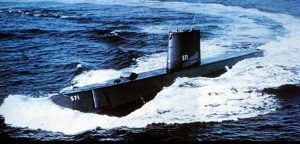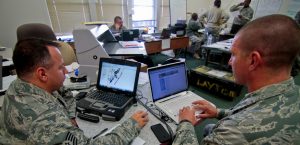 How long does it take the U.S. Army to buy a new handgun? One would think a 90 day market review of the current plethora of commercial handguns could lead to a quick fixed-price contract. Not so; it took them 10 years to prepare a 350 page Request for Proposal (RFP) plus 23 attachments, all released in 2015. After seeing the onerous RFP specifications, American handgun manufacturer, Ruger, chose not to bid. The final $580M contract was awarded to Sig Sauer in January of 2017, 12 years after the program was started.
How long does it take the U.S. Army to buy a new handgun? One would think a 90 day market review of the current plethora of commercial handguns could lead to a quick fixed-price contract. Not so; it took them 10 years to prepare a 350 page Request for Proposal (RFP) plus 23 attachments, all released in 2015. After seeing the onerous RFP specifications, American handgun manufacturer, Ruger, chose not to bid. The final $580M contract was awarded to Sig Sauer in January of 2017, 12 years after the program was started.
That is just one example of DoD acquisition processes gone haywire, as described in the May 2017 Interim Report of the Section 809 Panel on Streamlining and Codifying Acquisition Regulations. This panel was mandated in Section 809 of the National Defense Authorization Act, Fiscal Year 2016, and modified in the FY2017 NDAA. Per this statute:
“The panel shall—
(1) review the acquisition regulations applicable to the Department of Defense with a view toward streamlining and improving the efficiency and effectiveness of the defense acquisition process and maintaining defense technology advantage; and
(2) make any recommendations for the amendment or repeal of such regulations that the panel considers necessary, as a result of such review, to—
(A) establish and administer appropriate buyer and seller relationships in the procurement system;
(B) improve the functioning of the acquisition system;
(C) ensure the continuing financial and ethical integrity of defense procurement programs;
(D) protect the best interests of the Department of Defense; and
(E) eliminate any regulations that are unnecessary for the purposes described in subparagraphs (A) through (D).”
As the Interim Panel Report points out, despite DoD spending over $300 billion per year on research, development, and acquisition, the Defense Industrial Base (DIB) is no longer a dominant component of the U.S. economy.
“In the 1960s, the Fortune 100 included 15 defense firms that represented 30 percent of the [Fortune 100] revenue for the group. In 2017, the Fortune 100 includes only four defense firms, representing barely 3 percent of the revenue for the group.”
Further, the panel cites that DoD dominance in the semiconductor market has dropped from a peak of 90% to only 0.5% today.
Thanks to this Section 809 Congressional statute, our Nation has an opportunity to radically improve DoD acquisition practices. Unfortunately, acquisition regulation and process changes alone, will not address the key obstacles plaguing current DoD acquisition. These obstacles are:
- Speed to capability – is not a primary requirement for acquisition programs because risk-averse, bureaucratic, contracting and decision oversight processes are the primary driver of cost, performance, and schedule breaches.
- Accountability – program managers (PM’s), contracting officers, and legal advisors are virtually never held accountable for program cost, schedule, or performance breaches because program timelines require several PM tours to field a capability.
- Time is Money – the longer it takes to acquire anything, the more taxpayer dollars are spent, and the less modern capability is delivered to the warfighters.
 What is interesting is that these obstacles were not present in our Nation’s early acquisition cold-war successes. Nuclear submarines, Atlas ICBMs, and Polaris submarine ballistic missiles, are some the significant programs that developed winning cold-war capabilities in less than 5 years, from program start to first delivery, under a single PM.
What is interesting is that these obstacles were not present in our Nation’s early acquisition cold-war successes. Nuclear submarines, Atlas ICBMs, and Polaris submarine ballistic missiles, are some the significant programs that developed winning cold-war capabilities in less than 5 years, from program start to first delivery, under a single PM.
Not generally understood nor discussed is the unintended acquisition consequences triggered by the 1986 Goldwater-Nichols Act!
“In the more than two decades since that time of change… …some within the military services have grown increasingly concerned about some of the effects, perceiving a growing divide between a military-run requirements process and a civilian-run acquisition process—a divide they regard as inimical to the efficient and effective support of military forces.”
 So what is this inimical divide? Before Goldwater-Nichols, military Service Chiefs held dominant responsibility for acquisition programs. Because military officers have direct and personal concern about speed to capability, accountability, and effective military systems, they are personally driven toward successful results, not unlike early swordsmen and sword-makers had to be tightly connected.
So what is this inimical divide? Before Goldwater-Nichols, military Service Chiefs held dominant responsibility for acquisition programs. Because military officers have direct and personal concern about speed to capability, accountability, and effective military systems, they are personally driven toward successful results, not unlike early swordsmen and sword-makers had to be tightly connected.
Goldwater-Nichols, however, removed acquisition authority from the Service Chiefs and placed it under direct control of politically-appointed Assistant Service Secretaries. The senior DoD acquisition Secretary reports to the Secretary of Defense. Even though politically appointed DoD acquisition Secretaries work hard to deliver effective military capability, including those who are former military officers, subtle political pressures from Congress and the executive branch are often more interested in how and where defense acquisition dollars are allocated across their constituencies, and less concerned with delivered results.
With the Service Military Chiefs only able to set requirements, and approve and defend program budgets through Congress, they are unable to significantly influence what is built and delivered. The result has been:
- Lengthy, high-cost, ineffective Joint programs;
- Service programs second-guessed and stretched by OSD (Office of Secretary of Defense) staffs;
- Bureaucratic acquisition processes overly concerned with contract competition and contractor profits; and,
- Diminishing attention to rapid delivery of effective capability to the warfighters!
While Goldwater-Nichols was being established in the mid 1980’s, U.S. technology and manufacturing capabilities were growing rapidly, particularly in the information technology (IT) sector. Congress responded with a series of statutes directing the Federal government to buy, not build, all products that would approximately satisfy Federal and DoD requirements.
This began with the Competition in Contracting Act (CICA), 1984, mandating, “the use of commercial products whenever practicable,” and the Federal Acquisition Streamlining Act (FASA), 1994, leading to the military use of commercial computers, and to the Commercial Item procurement change, Part 12 of the Federal Acquisition Regulation (FAR) (FAR is the bible for Federal acquisition). For the first time, FAR Part 12:
 Prioritizes commercial item (CI) procurement and services, over other FAR Parts;
Prioritizes commercial item (CI) procurement and services, over other FAR Parts;- Mandates that requirements should be aligned with commercial items where possible;
- Reduces the contracting burden for buying fixed price CI and CI services; and,
- Requires market research as part of acquisition planning.
Market research is specifically called out in Part 12 because standing DoD acquisition processes rely upon Requests for Information (RFIs) to inform PM’s of available technology and interested contractors. The reality is that the majority of CI companies have no interest in contracting with the DoD because of bureaucratic contract and oversight burdens imposed on them create unnecessary expenses in return for slow, low probability-of-win, contract awards.
Many seniors in DoD argue that their DIB contractors will conduct market research and bring forward the best CI to satisfy DoD requirements. This ignores the obvious DIB conflict-of-interest that bringing forward CI and CI services reduces program dollars available directly to DIB contractors because they rely on unique DoD systems development and maintenance to sustain company growth. In addition, military Service requirements are not generated with an eye toward state-of-art CI capability, and are not easily tweaked across the Service Chief/Secretariat divide despite the commercial IT penetration in all military systems.
Fast forward 23 years and we find several NDAA Defense Bills demanding that DoD make better use of CI, CI services, FAR Part 12, and other laws designed to reduce the onerous DoD bureaucracy for non DIB contractors. Other Transaction Authority (OTA), 10 U.S. Code 2371, 2014, is one innovative example. This statute authorizes:
“The Secretary of Defense and the Secretary of each military department may enter into transactions (other than contracts, cooperative agreements, and grants) under the [non FAR] authority of this subsection in carrying out basic, applied, and advanced research projects.”
 The Defense Advanced Research Project Agency (DARPA) has made great use of OTA, and now military Services are building upon that success to extend this advantage through authorized OTA consortiums, such as C5. The C5 consortium brings together CI and new technology companies to rapidly deliver advanced C2ISR and Cyber technologies for military proof of concept prototypes.
The Defense Advanced Research Project Agency (DARPA) has made great use of OTA, and now military Services are building upon that success to extend this advantage through authorized OTA consortiums, such as C5. The C5 consortium brings together CI and new technology companies to rapidly deliver advanced C2ISR and Cyber technologies for military proof of concept prototypes.
In summary, if the Section 809 Acquisition Reform Panel does not address the key obstacles of (1) Speed to Capability; (2) Accountability; and, (3) Time is Money; modifying acquisition regulations and policies will have little to no effect, and certainly will not “maintain defense technology advantage!”
As long as acquisition programs are measured in decades and not PM tour timelines, the only bright light on the current horizon is taking full advantage of FAR Part 12 CI and CI services procurement along with OTA proof of concept prototyping. These statutes require no change to the current acquisition bureaucracy…

>> With the Service Military Chiefs only able to set requirements, and approve and defend program budgets through Congress, they are unable to significantly influence what is built and delivered.
Marv, The above is true, but less than the whole story. We seem to be incorrigibly unable to state requirements as in mission needs. Instead, requirements are stated in terms of the solutions perceived to be needed rather than the problems to be solved (aka the shiny box requirement). This is not just a training problem; in the IT world which has had rapidly moving technology for the last 50 years, it dooms us to yesterday’s solution, no matter how fast the paperwork can go.
Beyond that, in information systems, procurements tend to get less than the whole system (computers for the decision node, but no sensors or actors or comms to stitch all together, for example). This means that we have a driving — yea paramount — need for interoperability. But we haven’t even defined the term (it won’t even pass your spell-checker;-) and have no idea how to know when we have it or not. It’s not possible to put all the components in a single procurement so interoperability is critical. Interoperability has to be accompanied by vision, otherwise you’re standing on the fantail watching wake — interoperability with, say, Link 11 because that’s what I already have. Inherent interoperability (gained through good modularization) is essential to build in headroom for future.
Rex, always great and thoughtful comments. I completely agree. Further we treat requirements as if we need a new one to justify any funding spent on needed acquisition rather than understanding that improving existing C2ISR mission capability, as an example, can be a perfectly good standing requirement while we apply newer tech to improve capabilities for that requirement. This is not unlike my need for a more accurate mobile phone navigator. It has taken years, but now my processors and the cellular bandwidth are finally adequate for my phone to both effectively navigate me while I conduct my other business on the same phone.
Agree 100%. The IT Acquisition Advisory Council (IT-AAC) has hosted over 50 leadership workshops, assimilated over 40 major IT Reform studies, and reviewed some 30 major program failures. They all seem to follow the same pattern;
– Flawed market research (FEDBIZOPS is not research) that fails to reach real innovators
– Mis-use of a waterfall, industrial age DOD processes (JCIDS, DODAF, DoD5000, TRL)
– Inexperienced PMs and Acquisition staff who are more focused on compliance and outcomes. DAU trains only on policy, not execution
– Over reliance on often conflicted DIB/FFRDC contractors who profit from failure.
Marv,
A very good overview, but missing a few things. We have also divorced requirement from cost, and not put any systems in place to cancel programs early, when technology cannot deliver the capability in a cost effective way. F-35 is a prime example. Much of the program cost is not just driven by the Joint requirement (no one remembers the F-111), but by imposing capability requirements that couldn’t be met with existing technology. We don’t have a way to go back to the requirements community, and get them to either cut requirements or cancel the program, early in the life cycle. There are numerous programs that suffer from this. Low Cost Ship (LCS) is another example. A cheap, numerous, low crew vessel, designed to meet 90 percent or greater of Navy requirements to exercise with allies, establish supply lines via forward basing, and conduct light conflict missions like drug interdiction, anti-piracy, etc. Then it had to have more firepower, hunt mines, perform shallow water ASW, etc. Crew size grew to accommodate the extra missions, but in an expensive way by shore basing and crew and mission module swap out. We could have procured a frigate for the same final cost, in about half the time, with a more reliable platform and common weapons systems.
Had we had a more honest development process, and an easy way to cancel the program as cost to achieve stated requirements spiraled upward, we would be much closer to meeting the needs of the fleet.
Thanks Ken, you are adding good points. One of the big advantages of OTA prototyping is that we can more quickly learn about technologies and then use that knowledge to write better requirements. I believe we need to keep big “R” requirements much more general, and then use more empirical knowledge gained from prototypes to tailor the specs or little “r” requirements used for contracting. Today the program offices write there own requirements because the OPPNAV folks don’t have time or adequate knowledge, and then contractors write most of the specs. Because the system is so bloated with acquisition paperwork and briefing pipelines, way too little work is done to gain empirical knowledge of what can be built.